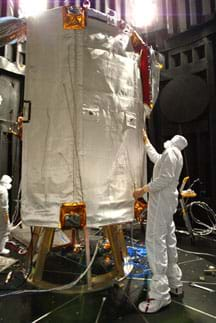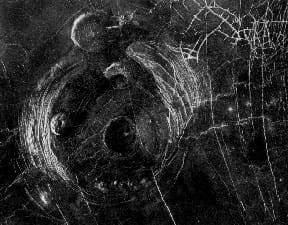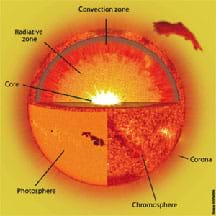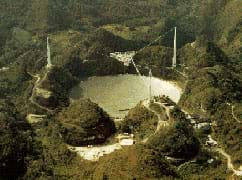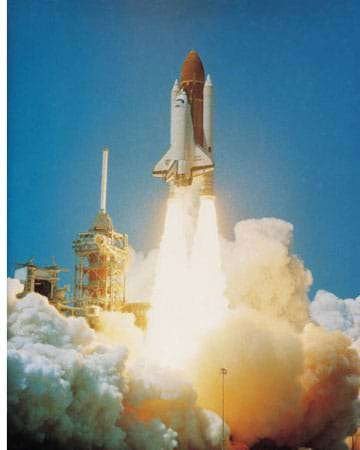Earth's Seasons
Our planet rotates on its imaginary axis at a surface speed of about one-half kilometer per second at the equator and revolves around the Sun at about 30 km per second. That's fast, but because motion is relative, we do not feel it. To us, the Earth seems to be standing still. Instead, we experience the motion of the Earth in the movement of the Sun across the sky and in the much slower cycle of the seasons. The four seasons are a result of Earth's axis of rotation being tilted at 23.5o.
Earth's Atmosphere
A thin layer of atmosphere — composed of 78% nitrogen, 21% oxygen, and 1% other constituents — separates us from the vacuum of space, shields us from harmful radiation coming from the Sun, and protects us from meteors, most of which burn up before they can strike the surface of the Earth. The part of the atmosphere that we call home — the troposphere — is an even thinner shell, only 12 km (7.5 mi) thick. It is in the troposphere where all our weather occurs.
Earth's Hydrosphere
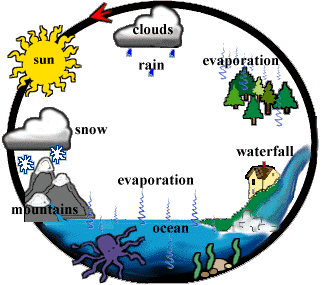
Water is liquid only within a narrow temperature span (0 to 100 oC). Contrasted with the full range of temperatures found in the solar system, this temperature span is especially narrow, neither too hot nor too cool. Fortunately for us, 70% of Earth's surface is covered by water: lakes, ponds, rivers, streams, creeks, oceans, seas, estuaries and tide pools. The rest of Earth is land: mountains and valleys, volcanoes, plains, deserts, forests and the boundary zones known as wetlands. Water vapor in the atmosphere is responsible for much of the Earth's weather and produces the water cycle that transports water as rain to sustain plant life on land. The water cycle (see Figure 2) consists of water evaporating from bodies of water and plants. It then condenses to form clouds, which travel around the planet. The clouds release the water as precipitation and then it flows back into bodies of water.
Earth's Lithosphere
The Earth is not a solid mass; it has several distinct layers, of which some are rigid and others are "plastic" or movable. The Earth's brittle crust floats on a liquid layer called the asthenosphere (see Figure 3). This liquid is molten rock (rock that has melted because of intense heat). We see this molten rock when it escapes as lava from volcanoes. The land masses of Earth are plates, rather like slices of bread floating on a very thick soup. These plates run into each other, under each other, and push against each other, causing earthquakes.
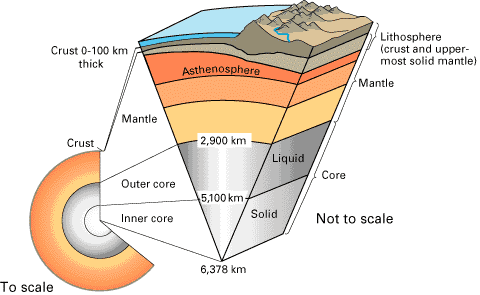
Earth's crust is divided into 10 major plates that are constantly on the move. The North American plate, for example, is moving west over the Pacific Ocean basin. The rate of speed is imperceptibly slow, roughly the rate our fingernails grow. But in time, give or take a few million years, we could be shaking hands with China. When the plates grind past one another causing earthquakes, we become suddenly aware of the movement of the plates. The plates also ride up over one another, or collide to make mountains, or split and separate. These movements are known as plate tectonics, a study that has fully developed only within the last 40 years.
Earth's Magnetosphere
Our planet's molten iron-nickel core and rapid spinning on its axis cause it to behave like the small bar magnets we have on Earth. The Earth has a North and a South Pole. However, satellite mapping has revealed that due to the effects of the solar wind (streams of charged particles emitted from the Sun) the magnetosphere is shaped more like a teardrop and has definite boundaries (see Figure 4).
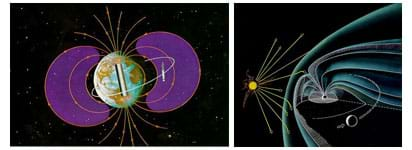
Planet Quick Facts
Amazing facts about Earth may be found in Table 1.
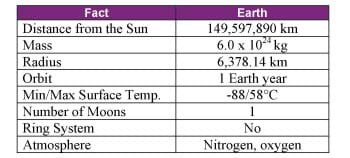
From: https://www.teachengineering.org/view_lesson.php?url=collection/cub_/lessons/cub_solar/cub_solar_lesson04.xml

